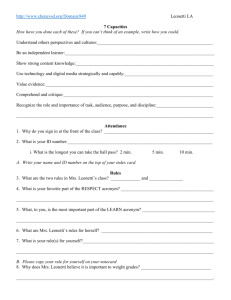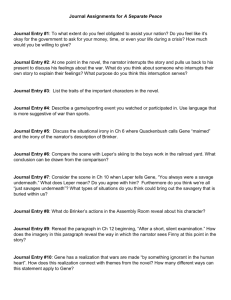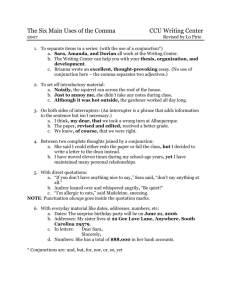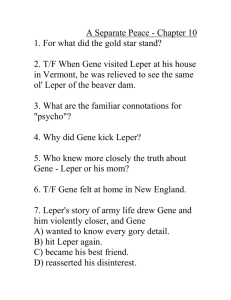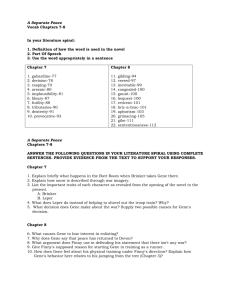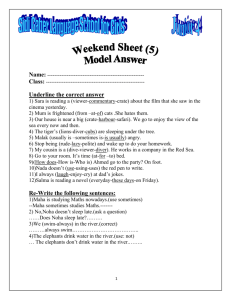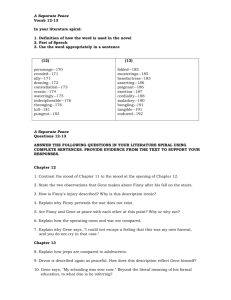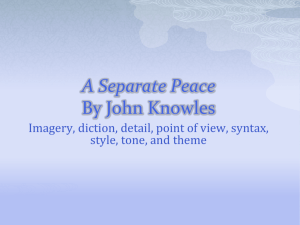A Separate Peace
advertisement
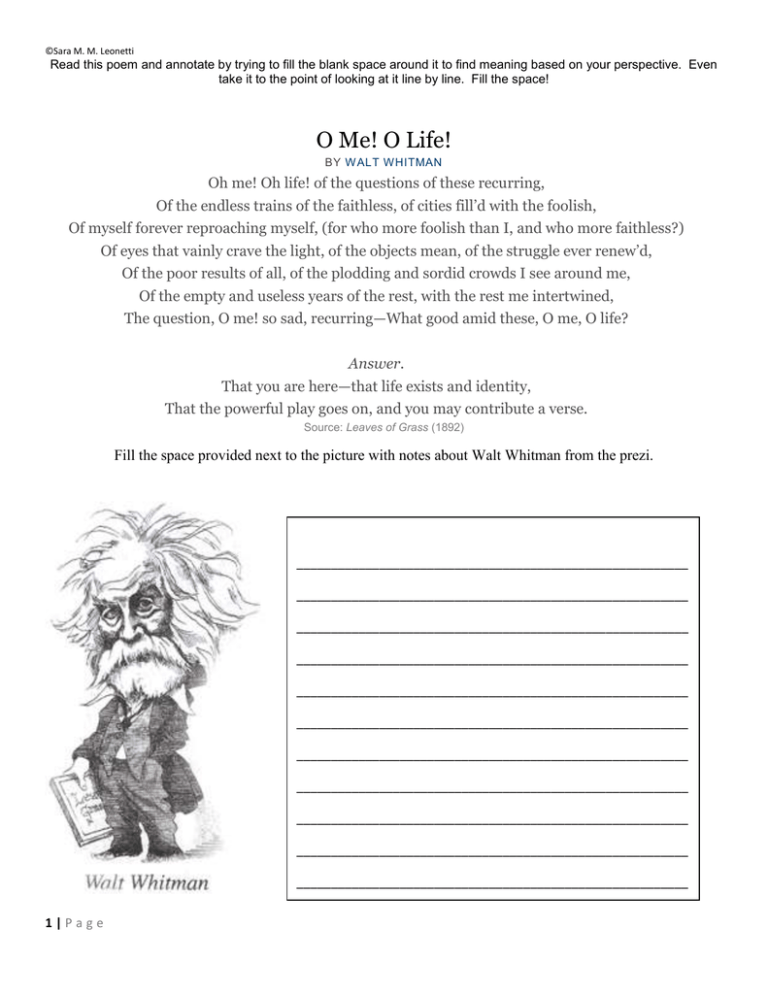
©Sara M. M. Leonetti Read this poem and annotate by trying to fill the blank space around it to find meaning based on your perspective. Even take it to the point of looking at it line by line. Fill the space! O Me! O Life! BY W ALT W HITMAN Oh me! Oh life! of the questions of these recurring, Of the endless trains of the faithless, of cities fill’d with the foolish, Of myself forever reproaching myself, (for who more foolish than I, and who more faithless?) Of eyes that vainly crave the light, of the objects mean, of the struggle ever renew’d, Of the poor results of all, of the plodding and sordid crowds I see around me, Of the empty and useless years of the rest, with the rest me intertwined, The question, O me! so sad, recurring—What good amid these, O me, O life? Answer. That you are here—that life exists and identity, That the powerful play goes on, and you may contribute a verse. Source: Leaves of Grass (1892) Fill the space provided next to the picture with notes about Walt Whitman from the prezi. _________________________________________________________ _________________________________________________________ _________________________________________________________ _________________________________________________________ _________________________________________________________ _________________________________________________________ _________________________________________________________ _________________________________________________________ _________________________________________________________ _________________________________________________________ _________________________________________________________ 1|Page ©Sara M. M. Leonetti Take notes on John Knowles, WWII, and A Separate Peace on the tree. ____________________________________________________________________________________________________________ ____________________________________________________________________________________________________________ ____________________________________________________________________________________________________________ ____________________________________________________________________________________________________________ ____________________________________________________________________________________________________________ ____________________________________________________________________________________________________________ ____________________________________________________________________________________________________________ ____________________________________________________________________________________________________________ ____________________________________________________________________________________________________________ Cut the paper in ½ and paste each side into your journal 2|Page ©Sara M. M. Leonetti Anticipation/ Reaction Guide: A Separate Peace Part I - Before Reading: Look at each statement below. In the Before column, place a plus sign (+) next to each statement you agree with, a minus sign (–) next to each statement you disagree with and a question mark (?) if you are unsure of your belief. Write your reasoning above the statement. Part II - After Reading: Look back at each statement. In the After column, place a plus sign (+) next to each statement you agree with, a minus sign (–) next to each statement you disagree with and a question mark (?) if you are unsure of your belief. Write your reasoning below the statement. Part III – Reaction: Compare the before column with the after column. Where has your opinion changed after reading the story? Where has it stayed the same? Why has your opinion changed and/or stayed the same. Write your observations on the back in a 150+ word description. BEFORE _____ Statements Jealousy can destroy friendships and ruin lives. AFTER _____ _____ Even if you never see war first hand, it can still impact your life. _____ _____ Bad actions, made out of impulse, should not be held against you. _____ _____ Even if you were intentionally hurt by them, it is easy to forgive a friend. _____ _____ Rules are only made to be broken. _____ _____ Telling the truth is important, even if the truth will hurt. _____ _____ Those that we love can hurt us the most. _____ _____ There is good and bad in everyone _____ _____ Growing up and maturing is very easy _____ 3|Page ©Sara M. M. Leonetti LA 12 Fall A Separate Peace Map Assignment Because the setting is so important to the novel, let’s try to picture it. With your group of 4 or less, create a picture of Devon and the grounds. Include at least the following locations: the tree, beach, playing field, Boat House, Assembly Room, Winter Carnival, and Butt Room. These next locations don’t require quotes, but include them on the drawing: both rivers, Commons (p.144), gym, school buildings, tennis courts, stadium, and woods. Include the following characters: Gene, Finny, Leper, Brinker, and Quackenbush. At each location listed write a quote and page number showing what the character did or said at that spot. Your group will decide the best location for each character. Some characters will need to be used more than once. Be creative, but also be as accurate as you can. You might want to design your drawing before you begin on the butcher paper. Your main focus is building a bank of quotes for your thesis, so do your best with the art, however, we are not studying art skills, so that is secondary for this task. (5) Exceeds expectations Criteria Checklist Description Locations with descriptive quotes with page number Tree Beach Playing Field Boat House Assembly Room Winter Carnival Butt Room Both Rivers Commons Gym School Buildings Tennis Court Stadium Woods Beach or Boardwalk Gene Finny Leper Brinker Quackenbush Illustrate in color each of these settings and describe with 3 sentences that include claim, citation, and clarification of the locale. Locations Illustrations Characters Literary Terms Group Work Final Product Foreshadowing Mood Personification Simile Metaphor Motif Antagonist Protagonist Collaborate Use in-class time Positive attitude Accurate Creative Neat Colorful (4)Meets expectations (3) Missing 1-2 items (2) Missing 3+ items (1) Incomplete Neatly illustrate in color each of these settings to reflect the whole campus of Devon. Include each character at least once in a place where they make a significant contribution to the story—include and important quotation from or about the character that characterizes him. Label where each of these terms plays a role in the story with the quotes you have already included from the characters or locations. Using all give time in class, work together, evenly distribute workload, and maintain a positive attitude. The final product is pleasing to look at, and it is clear the group as a whole is proud of their work. Total _____/30 4|Page ___________% ©Sara M. M. Leonetti 1. Describe Devon. How is it similar AND different to CHS? Devon is: Similarities Differences 1. What are the two places our narrator goes to visit? What kind of places are these places? (hint: it is an emotion). These places are ________________ places 1. 2. 2. How does Knowles use the weather in chapter one to set the mood and let us know what the protagonist is feeling? 3. “The more things remain the same, the more they change after all.” Describe what has changed for our narrator since the last time he was at Devon? 4. Foreshadowing is seen when Knowles writes: “Noting endures, not a tree, not love, note even a death by violence.” What do you think this could mean? Forecast what you think will happen in this novel. Write a very detailed description in a paragraph or two. (Think about your answer to # 2 and how those two places come into play). 5|Page ©Sara M. M. Leonetti Excerpt from Chapter 3: A Separate Peace Enough broken rules was enough that night. Neither of us suggested going into any of the honky-tonks or beer gardens. We did have one glass of beer each at a fairly respectable-looking bar, convincing, or seeming to convince the bartender that we were old enough by a show of forged draft cards. Then we found a good spot among some sand dunes at the lonely end of the beach, and there we settled down to sleep for the night. The last words of Finny’s usual nighttime monologue were, “I hope you’re having a pretty good time here. I know I kid of dragged you away at the point of a gun, but after all you can’t come to the shore with just anybody and you can’t come by yourself, and at this teen-age period the proper person is your best pal.” He hesitated and then added, “which is what you are,” and there was silence on his dune. It was a courageous thing to say. Exposing a sincere emotion nakedly like that at the Devon School was the next thing to suicide. I should have told him then that he was my best friend also and rounded off what he had said. I started to; I nearly did. But something held me back. Perhaps I was stopped by that level of feeling, deeper than thought, which contains the truth. Answer each of the following questions in the space below and on the back. Use the excerpt above to help you. Be specific!!! 1. Where are the boys at the close of the 3rd chapter? 2. What they have been doing all day? 3. What are Gene’s feelings about Finny? How do you know? 4. Why doesn’t Finny want Gene to tell anyone about his beating the swimming record? What does that tell you about the type of person Finny is? 6|Page ©Sara M. M. Leonetti A Separate Peace: Chapter 5-7 Choice After reading time today, choose which option you would like to complete based on both your own abilities and what you have read so far, OR for extra credit, complete both. Whichever you choose you must do it to the BEST of your ability. Option 1: Write an acronym poem using the word GUILT. Write a line or more that begins with each letter in the word. Your poem should include ideas about how Gene is feeling during these chapters. Cite specific scenes or lines from the book. G____________________________ ______________________ U____________________________ ______________________ I_____________________________ ______________________ L_____________________________ ______________________ T_____________________________ ______________________ 7|Page ©Sara M. M. Leonetti Option 2: Re-read the lines below and draw a picture using color to depict EXACTLY what is described in the excerpt then describe on the lines below the context of the scene. “ . . . Phineas in exaltation, balancing on one foot on the prow of a canoe like a river god, his raised arms invoking the air to support him, face transfigured, body a complex set of balances and compensations, each muscle aligned in perfection with all the others to maintain this supreme fantasy of achievement, his skin glowing from immersion his whole body hanging between river and sky as though he had transcended gravity and might be gently pushing upward with his foot glide a little way higher and remain suspended in space, encompassing all the glory of the summer and offering it to the sky” (Knowles). _____________________________________________________________________________________ _____________________________________________________________________________________ _____________________________________________________________________________________ _____________________________________________________________________________________ _____________________________________________________________________________________ _____________________________________________________________________________________ _____________________________________________________________________________________ _____________________________________________________________________________ 8|Page ©Sara M. M. Leonetti Winter’s Occupation Motif – A Separate Peace Definition of Motif, according to the American Heritage Dictionary: A recurrent thematic element in an artistic or literary work a dominant theme and central idea Take a look at the two passages from the novel below to see the growth of a motif: Chapter 7 “Not long afterward, early even for New Hampshire, snow came. It came theatrically, late one afternoon; I looked up from my desk and saw that suddenly there were big flakes twirling down into the quadrangle, settling on the carefully pruned shrubbery bordering the crosswalks, the three elms still holding many of their leaves, the still-green lawns. They gathered there thicker by the minute, like noiseless invaders conquering because they took possession so gently. I watched them whirl past my window—don’t take this seriously, the playful way they fell seemed to imply, this little show, this harmless trick” (Knowles 83). Chapter 9 “Winter’s occupation seems to have conquered, overrun and destroyed everything, so that now there is no longer any resistance movement in nature; all the juices are dead, every sprig of vitality snapped, and now winter itself, an old, corrupt, tired conqueror, loosens its grip on the desolation, recedes a little, grows careless in its watch; sick of victory and enfeebled by the absence of challenge, it begins to withdraw itself from the ruined countryside” (Knowles 119). These two quotes are from two different areas of the book A Separate Peace. Still, it is obvious that they use similar figurative language. There are other areas of the book that this same figurative language is used. When a metaphor is used many times throughout a book or poem, it is called an extended metaphor. Since the author continually returns to these same ideas, they are technically also part of a motif. What extended metaphor is used here? Winter is compared figuratively to an attacking army. Winter is not intentionally violent – it is a season of the year. We assume that the seasons do not do anything intentionally. For instance, the cold of winter does not literally attempt to attack us. Yes, it is uncomfortable for us, but winter does not consciously try to make us uncomfortable. Knowles compares the cold and snow of winter to an attacking army for many good reasons. First, one of the major subjects of the book is war, so comparing winter to an army makes sense. Secondly, since it is Gene describing winter in this way, it reveals how he feels, not just about winter but about his life. Knowles wants to communicate to readers how Gene feels, so he has him describe winter with dark, even violent imagery. This description also impacts the mood, which is the ways readers feel about the passage. Lastly, Knowles makes use of a special type of metaphor known as personification. This occurs when an author figuratively compares non-human objects or ideas to people. Knowles said the snowflakes “gathered…like noiseless invaders conquering because they took possession [of nature] so gently.” The “playful” snow snuck in while telling nature, “don’t take this seriously…this little show, this harmless trick.” The snowflakes are compared to paratroopers, which humanizes them. In the second quote, Knowles said, “Winter’s occupation seems to have conquered, overrun and destroyed everything,” leaving nature without any “resistance movement.” Eventually, winter becomes “an old, corrupt, tired conqueror” who “loosens its grip,” “grows careless,” “sick of victory and enfeebled by the absence of challenge.” Therefore, it begins to “withdraw itself from the ruined countryside.” The author personifies all aspects of nature, figuratively comparing it to both the conqueror and the conquered. Obviously, this is relevant given that the setting of the book was World War II, a time that included Hitler, Mussolini and Stalin. Again, Knowles uses figurative language that is relevant both historically and thematically. These vague references to the tyrants of that age are examples of historical allusion. Adapted from: http://blog.oakland.k12.mi.us/russell/?s=A+Separate+Peace 9|Page ©Sara M. M. Leonetti Trying out Motifs: A Separate Peace Now that we have a better understanding what a motif is, let’s try our hand at creating out own motif. To better understand literary devices sometimes it is best to actually attempt to use it yourself. I don’t anticipate we will all write as well as John Knowles (maybe you will be even better), but I do want you to attempt to create your very own motif. Although Knowles uses a motif of war that is dark and serious, your motif could be light and funny if you so wish. To create your own motif, think over your time as a senior, so far. How would you describe it? Gene would describe his winter months as that of someone going to war in order to show you how he is feeling about his life during those winter months. Knowles even goes so far as to use references to military equipment and arsenals as much as possible, giving the reader the feeling that Gene is at war with himself as well as the people around him. He is hiding, defensive, aggressive and defending himself from ‘attack’ at whatever the cost, hurting whoever gets in his way. What comparison would you make to your own life? Write a 300+ word creative writing snippet that describes how you view your experiences so far in your senior year. You do not have to get into the specifics of what has happened to you, but you should allow the comparisons you chose for your figurative language and metaphor to talk for you. In other words, pick a comparison that can allow the reader to feel what you feel about the year thus far. Gene is simply describing the natural world and his setting but is using figurative language, metaphors, personification and historical allusions in order for you to see similarities between the winter months and the war, so that the reader can see that Gene feels at war during these winter months. For your own life, could you compare it to a circus, a car wash, an MMA match? Maybe it’s more like a rock concert, Christmas morning or a James Bond flick. Whatever your choice, make sure the comparison is surprising and interesting. In your short snippet you must use the following literary devices to create your motif: Device Definition Figurative Language Metaphor Personification Historical Allusion Figurative language is not intended to be interpreted in a literal sense. Appealing to the imagination, figurative language provides new ways of looking at the world. It always makes use of a comparison between different things. Figurative language compares two things that are different in enough ways so that their similarities, when pointed out, are interesting, unique and/or surprising. A figure of speech that compares two things that have something in common. Unlike similies, metaphors do not use the word like or as, but make comparisons directly. Giving human traits (qualities, feelings, action, or characteristics) to non-living objects (things, colors, qualities, or ideas). A brief reference to a person, event, or place, real or fictitious, or to a work of art. Casual reference to a famous historical or literary figure or event. An allusion may be drawn from history, geography, literature, or religion. To help you begin your own motif, use the starter sentence below and build your motif from there. Feel free to write directly onto the bottom of this sheet, or write on your own lined paper and attach it to this handout. I awoke with a start, surprised to find… Created by Jessica Ohman 10 | P a g e ©Sara M. M. Leonetti Chapters 8 and 9 Excerpt from A Separate Peace by John Knowles, Chapter 9: I took the telegram from Phineas, facing in advance whatever the destruction was. That was what I learned to do that winter. I HAVE ESCAPED AND NEED HELP. I AM AT CHRISTMAS LOCATION. YOU UNDERSTAND. NO NEED TO RISK ADDRESS HERE. MY SAFETY DEPENDS ON YOU COMING AT ONCE. (signed) YOUR BEST FRIEND, ELWIN LEPER LEPELLIER FREE WRITE: What is going on when Gene gets the telegram? Where do you think the ‘Christmas location’ is? 11 | P a g e ©Sara M. M. Leonetti Why do you think Leper signs the letter ‘your best friend’? Why do you think it is Gene that Leper reaches out to and no one else? Escaped is a funny word to use. Could Leper have escaped from the army or do you think it’s from something else entirely? Explain. Finny and showing weakness: 12 | P a g e ©Sara M. M. Leonetti Finny and the war: Why is Leper a ‘joke’? Excerpt from A Separate Peace In the silences between jokes about Leper’s glories we wondered whether we ourselves would measure up to the humblest minimum standard of the army. I did and knew that I did not know it; I wondered in the silences between the jokes about Leper whether the still hidden parts of myself might contain the Sad Sack, the outcast, or the coward. We were all at our funniest about Leper, and we all secretly hoped that Leper, that incompetent, was as heroic as we said. Everyone contributed to this legend except Phineas. At the outset, with the attempt on Hitler’s life, Finny had said, “If someone gave Leper a loaded gun and put it at Hitler’s temple, he’d miss.” There was a general shout of outrage, and then we recommended the building of Leper’s triumphal arch around Brinker’s keystone. Phineas took no part in it, and since little else was talked about in the Butt Room he soon stopped going there and stopped me from going as well – “How do you expect to be an athlete if you smoke like a forest fire?” He drew me increasingly away from the Butt Room crowd, away from Brinker and Chet and all other friends, into a world inhabited by just himself and me, where there was no war at all, just Phineas and me alone among all the people of the world, training for the Olympics of 1944. Explanation of the above excerpt: 13 | P a g e ©Sara M. M. Leonetti Free Write: Opinion In the box below: In your own words, define the following terms and answer the questions that follow. (Take a guess if you don’t know…) Codependency Identity 1. What do these two words have to do with A Separate Peace? 2. How is the novel a war novel when we don’t actually see the war? What “war” are these boys really fighting? 14 | P a g e ©Sara M. M. Leonetti Finny + Gene (Friendship) Aspect #2: Aspect #1: Aspect #3: Rivalry Trust/Support Friendly Competition Jealousy Jealousy: Rips Gene in two Push to be a better student ← GENE→ Hurt Finny to help himself (A positive and good thing) (A negative and bad thing) Remember according to Knowles: It is human nature to create an enemy for yourself! Identity + Leper Does his own thing: Loner who sees world differently Ski Troops Leper’s Self Identity Age: He has to grow up more quickly 15 | P a g e WAR: Too much to handle P.T.S.D ©Sara M. M. Leonetti P.T.S.D = Post Traumatic Stress Disorder Intrusive, upsetting memories of the event Flashbacks (acting or feeling like the event is happening again) Nightmares (either of the event or of other frightening things) Feelings of intense distress when reminded of the trauma Intense physical reactions to reminders of the event (e.g. pounding heart, rapid breathing, nausea, muscle tension, sweating) In extreme cases, a person can actually hallucinate to detach from the world. Leper tells the truth: Gene is a “Savage Underneath” A Savage is: Gene fits this description because: Other Reactions to the War: World War II is only the EVENT that pushes these boys to cause change in their lives. The stress of this event changes how these boys react to the normal pressures of life. Each one of our main characters reacts differently to the war. Describe how each of these characters reacts. Brinker Hadley: This character says: Why this character may believe this/feel this way: 16 | P a g e ©Sara M. M. Leonetti Leper: This character says: Why this character may believe this/feel this way: Gene: This character says: Why this character may believe this/feel this way: Finny: This character says: Why this character may believe this/feel this way: 17 | P a g e ©Sara M. M. Leonetti Complete as you watch: A Separate Peace Dead Poets Society Setting Character 1 Character 2 Society Major Theme After filling out the boxes, summarize the similarities between A Separate Peace and Dead Poets Society. Explain using details from each: _____________________________________________________________________________________ _____________________________________________________________________________________ _____________________________________________________________________________________ _____________________________________________________________________________________ _____________________________________________________________________________________ _____________________________________________________________________________________ _____________________________________________________________________________________ _____________________________________________________________________________________ _____________________________________________________________________________________ 18 | P a g e ©Sara M. M. Leonetti Review our Overarching Idea: “That the powerful play goes on, and you may contribute a verse.” Explain where this quote came from and why it is meaningful to the boys in A Separate Peace, Dead Poet’s Society, and you. _____________________________________________________________________________________ _____________________________________________________________________________________ _____________________________________________________________________________________ _____________________________________________________________________________________ _____________________________________________________________________________________ _____________________________________________________________________________________ _____________________________________________________________________________________ _____________________________________________________________________________________ _____________________________________________________________________________________ _____________________________________________________________________________________ _____________________________________________________________________________________ _____________________________________________________________________________________ _____________________________________________________________________________________ _____________________________________________________________________________________ _____________________________________________________________________________________ _____________________________________________________________________________________ _____________________________________________________________________________________ _____________________________________________________________________________________ _____________________________________________________________________________________ _____________________________________________________________________________________ _____________________________________________________________________________________ _____________________________________________________________________________________ _____________________________________________________________________________________ 19 | P a g e ©Sara M. M. Leonetti Memoir Writing Peer Review Checklist Writer's Name _________________________ Reviewer's Name ________________________ Questions Yes No. Has the writer narrowed the topic to one item and focused on the purpose? . . Is there evidence of an individual voice? Can you "hear" the writer? . . Does the piece develop ideas by using interesting or important experiences of the writer? . . Does the writer place ideas and details in meaningful order? . . Does the writer provide the reader with a natural flow and sequence to the story? . . Does the writer use imagination and creativity? . . Can the reader understand the importance of the relationship between the writer and the subject of the writing? . . *Please circle any similes and/or metaphors *Please box any of the five senses you see Does it have a title? yes no Is it interesting/powerful? Does the first sentence grab you? What could make it stronger? Where does this story take place? How do you know? Who is the strongest character? What are three things that make the character strong? What would make the other characters more real? Where are the holes in the story? How could this story be more real? What is the point of the story? Are you satisfied by the conclusion? What could make it stronger, more complete? 20 | P a g e ©Sara M. M. Leonetti 21 | P a g e ©Sara M. M. Leonetti The Lively Art of Writing Homework Read The Lively Art of Writing chapter 1, p. 16-20 Helps with Focus Answer: What is an opinion? How do you reach it? What makes an opinion interesting? Read “Believe What You Say” p. 21-22 Helps with Focus Choose which essay option you want to complete for the semester. This REALLY needs to be something you can get on board with, or your whole essay will flounder. Read Chapter 2, p. 25-32 Helps with Focus Answer: What is the difference between opinion and thesis? Why is qualification of a thesis important? Read Chapter 3, p. 33-39 Helps with Focus Answer: Explain the relationship of the full thesis to the psychology of argument. Why should the full thesis statement be kept in view when you are writing an essay? Read Chapter 4, p. 41-58 Helps with Development 22 | P a g e Create: An outline that shows the structure of the essay. Explain how each is used within the shapes—this should be in your own words. ©Sara M. M. Leonetti The Lively Art of Writing Homework Read The Lively Art of Writing chapter 5 “First Steps Toward Style”, p. 56-67 Helps with Language and Style In what way is style in writing similar to style in any kind of activity? Why does the use of the personal pronoun frequently weaken a writer’s statement? To support your answers, give examples other than those used in the text. Read chapter 6 “The Size and Shape of Middle Paragraphs” p. 70-78 Helps with How does the structure of a middle paragraph differ from the structure of an introductory paragraph? From that of a concluding paragraph? Development In what way does the structure of a paragraph resemble the structure of a full essay? Read chapter 7 “Connections Between Paragraphs” p. 80-90 Helps with Cohesion Describe a standard transitional device. Is one kind of transition better than any other kind? If so, why? If not, what is the best guide for deciding which kind of transition to use after you have made certain that you are being clear? Read chapter 8 “The Passive Voice” p. 93-101 How can you convert a sentence containing a “by—“ phrase from passive to active voice? Helps with Language and Style What one rule will help you to avoid passive voice? What is the “cut-it-off-at-the-pass” technique in reference to the passive voice? 23 | P a g e ©Sara M. M. Leonetti The Lively Art of Writing Homework Read The Lively Art of Writing chapter 9, p. 103-120 Helps with Language and Style Answer: What are three main places in a sentence where details can be added? Name three ways of constructing graphic details. How do you add details to a verb? Read chapter 10, p. 123-130 Helps with Cohesion What is the best way to learn parallel structure? Paralellism “is a repetition of structure.” Explain. Read chapter 11, p. 133-142 Will your writing have more dignity if you make a point of using big words in place of smaller, more familiar words? Helps with What is the difference between a metaphor and a simile? Language and Style What is an allusion? Read chapter 12, p. 145-153 Explain the real purpose of punctuation and illustrate is relation to sound. Helps with Conventions What kind of pause does a comma indicate? Explain the proper use of a semicolon. 24 | P a g e ©Sara M. M. Leonetti “Everyone is born with tremendous capacities for creativity.” ~ Dr. Ken Robinson Chapter Four Questions: The Element: “In the Zone” Directions: Using complete sentences, please answer the following questions thoroughly and thoughtfully in your journal. 1. Who is Ewa Laurance? 2. What was her epiphany? 3. What did her parents think? 4. What does she think about Geometry? 5. What does it mean to be “in the zone”? 6. Give an example of what you have been “in the zone”. 7. Who is Aaron Sorkin? 8. What made him fall in love with writing? 9. Why is doing the thing you love to do no guarantee that you’ll be in the zone every time? 10. Have you ever had an experience where things just seemed to “fall into place”? Explain. 11. Describe what it means to be in the zone. 12. How does Dr. Mihaly Csikszentmihalyi describe “flow”? 13. Why is finding your Element vital to everyone? 14. How did Black Ice find his Element? 15. “When you are inspired, your work can be ____________________ to others.” 16. “Intelligence is ___________ for every individual.” ------------------------------------------------------------------------------------------------------------------------------------17. Take your personality profile on the pages provided. 18. What does Robinson say about categorizing thinking styles and personality types? 19. How many personality types does he think there are? 20. Who is Terence Tao? 21. How old was he and how did he learn to read? 22. What is the vitally important question we should ask ourselves? 23. What is your answer to that question? 24. Do you feel the profession you have chosen is your “element”? Why or why not? 25 | P a g e ©Sara M. M. Leonetti “At the most basic levels, professionals in any field are simply those people who earn their living in that field, while amateurs are people who don’t.” ~ Dr. Ken Robinson Chapter 10 Questions: The Element: “For Love or Money” Directions: Using complete sentences, please answer the following questions thoroughly and thoughtfully. 1. Who is Gabriel Trop? 2. What did he decide to do about his love for playing the cello? 3. From the context of the paragraph it's in, what does pejorative mean? 4. How does this impact our understanding of amateur? 5. What does amateur mean from its Latin roots? 6. What are a few accomplishments from the "pro-am revolution"? 7. What does it help them compensate for? 8. What are 2 of Clarke's wishes in the video? 9. What did he invent that we use every day? 10. What did he write? 11. What was he an amateur of? 12. What did Susan Hendrickson do that you shouldn't? 13. What did she join in 1990? 14. What made her famous? 15. Where did Tiff Wood discover his element? 16. Many people earn their living doing one thing, and they then create ______________ and _______________ in their lives to do the thing they love. 17. Where did Robinson find a surfing photographer? 18. How do corporate rock bands make a difference in New York? 19. Why is it important that the players in the band are using their "element" even if it's not for their career? 26 | P a g e ©Sara M. M. Leonetti 20. If we're not in our element at work, it becomes even more _________________ to discover that Element somewhere else. 21. Who was Khaled Hosseini before he became a writer? 22. Where is he from? 23. What did he write? 24. Who created Room to Read? 25. How did he come up with the idea? 26. How would the world be different if he hadn't? 27. What's the difference between leisure and recreation? 28. Which one does Robinson associate with the Element? Why? 29. What is Suzanne Peterson's "real" job? 30. How does she practice on planes? 31. Her life has added meaning because she's chosen a recreational pursuit that is _________. 32. How did Suzanne's sister find her Element? 33. Why didn't she pursue this as a career? 34. We all need to find a balance between making a __________ and making a ____________. 35. Take this test: http://travel.nationalgeographic.com/travel/happiest-places/test/ 36. When you get back cut out your results and paste them into your journal. 37. Next to your results explain how accurate you think they are in a short paragraph. 38. Read the last paragraph in the chapter and answer: If you want to change the world, who do you begin with, yourself or others? 27 | P a g e ©Sara M. M. Leonetti Outline Assignment 1. 2. 3. 4. 5. 6. Create rough draft of outline based on the exact format below. Fill in as many sections as you can with ideas for your paper. If you do not know what to put in a section, highlight it here. Use your outline to help you write your paper. Your paper must be organized in this way. a. Each Roman Numeral is a section b. Each Letter is a paragraph in sections II and III. As you write your annotated bibliographies number them, include the number of those in the space provided to help you stay organized. Keep your outline in your research folder at all times. Heading (10 Pts.) Lastname 1 Student Name Teacher Name Class, Period Day Mo. Year Title Outline I. Introduction (15 pts.) a. Hook (quotation, analogy, main idea, call to action) (__________________) b. Explain hook c. Explain significance of hook d. Transition from hook to thesis statement (otherwise known as forecast sentence) e. Thesis statement (forecast sentence)—what is the paper going to be about? Oftentimes, it is best to use a compound-complex sentence here because it should detail all of the sections that you will discuss. The following sections can come in any order. You will be using one of the sections twice, depending on whether you are researching two “schools” and one career or two careers and one “school”, BUT, you only need to write about one “school” and one career in your final draft. 28 | P a g e ©Sara M. M. Leonetti II. Career(s) a. Introduce and describe the career(s) you are interested in (5 pts.). (__________________) i. Explain why you are interested in that career (5 pts.). b. Nature of the work (5 pts.) (__________________) i. Training c. 1. skills needed 2. education needed 3. experience required Job Outlook (5 pts.) (__________________) i. Projection III. d. Earnings/Wages (5 pts.) e. Based on the above, do you think this is the career for you? (5 pts.) (__________________) “School”(s) a. Introduce the “school”(s) you are interested in (5 pts.). (__________________) i. Explain why you are interested in that “school” b. Describe the “school” (5 pts.) (__________________) i. Location (environment) ii. Extra-curricular activities you might enjoy c. What are the entrance requirements? (5 pts.) (__________________) d. Does it have the major or training you require for your career choice? (5 pts.) (__________________) e. What is the cost or time frame? (5 pts.) (__________________) f. 1. Tuition or Years Required 2. Room and Board or Boot Camp location 3. Food or Medical Requirements 4. Scholarships available or Benefits of service How will this “school” help you to get where you are going? (5 pts.) i. Based on the above, do you think this is the “school” for you? IV. 29 | P a g e Summary and Conclusion (15 pts.) a. Refocus on hook b. Compare your two careers or two “schools”. c. Explain what decision you have come to and why. (__________________) ©Sara M. M. Leonetti Annotated Bibliography Assignment Annotated Bibliographies are a very useful tool when writing a research paper. They are like an advanced method for making notecards or taking notes. The idea is that after you thoroughly read one of your sources you summarize for ½ page and respond for the second ½ of the page. In this way you can avoid forgetting what your source was about, have the important quotations or paraphrases readily available, and remember your reaction to what you read. Also, it includes your works cited information at the top. Therefore, you have everything you need to put together your research folder Requirements for this assignment: Create 5 annotated bibliographies Each annotated bibliography must include: Correct works cited at the top ½ page summary of source ½ page response to source At least 1 quotation or paraphrase properly cited Bibliographies should be double spaced What’s the point? Have your information in an easily accessible format Since they will be typed, you can easily cut and paste information out of your bibliographies into your final paper. You will have already found 5 of your sources and cited them. All you have to do is cut and paste the citation into your Works Cited page. Please see the back of this page for an example of an Annotated Bibliography. 30 | P a g e ©Sara M. M. Leonetti ANNOTATED BIBLIOGRAPHY EXAMPLE Eberts, Marjorie, and Margaret Gisler. Careers for Bookworms and Other Literary Types. Illinois: VGM Career Horizons, 1993. Print. Careers for Bookworms and Other Literary Types describes several different options for people who enjoy reading. Most notably it describes the duties of librarians and all of the different places a librarian could work. Usually one only thinks of librarians as those who work in our public schools or libraries. However, here it can be seen that they can work with lawyers, doctors, or other professionals as well as the typical school librarian. Most importantly, though, is the description given for a librarian: The librarian sitting behind a desk at your local library is doing far more than reading as he or she spends a lot of time answering questions and helping patrons. But the librarian also has the chance to see new books coming into the library, to read reviews of books in an assigned area in order to find books to order, and to put together books lists. Some time may also be spent in newspapers to update sources or to clip materials for various files (Eberts and Gisler 12). This gives a hopeful librarian a lot to think about. Although most who would consider being a librarian would do so because they like reading, it appears that they will also have to be willing to work with people and sometimes read articles or books that they may not necessarily be interested in. This book gave me a lot to think about because it did a good job describing what a librarian does. It also gives ideas about the different kinds of librarians I could be, and it asks important questions that helped me to decide whether or not this job is for me. Lastly, I really enjoyed that it listed both the negative and positive aspects of being a librarian. This book really gave me a lot to think about. 31 | P a g e
